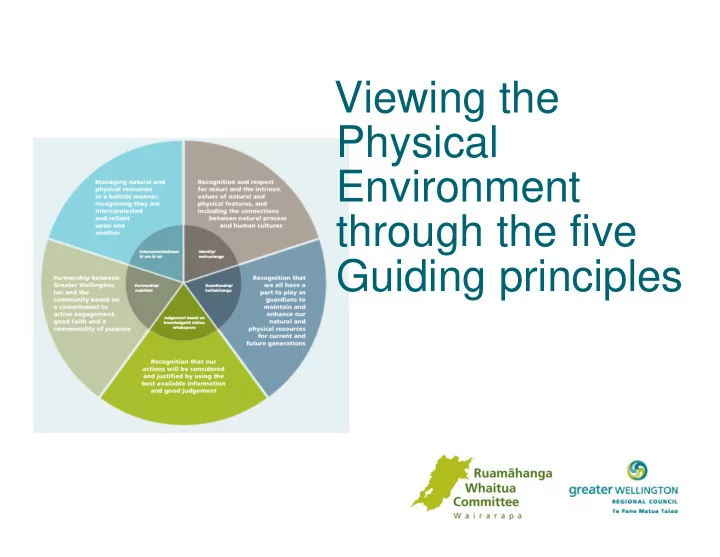

Viewing the Physical Environment through the five Guiding principles
Identity | wairua Landscape character and identity is formed from people’s connection to places, the way they use and relate to place . How does people’s use of the river, streams and lakes shape our identity? How do we see our rivers? – the river as nature- the river as resource | sustenance- the river as a tonic for health and wellbeing- the river as our identity. How do wetlands shape our identity?
Identity | wairua
Crassula Ruamahanga Caspian Tern
Identity | wairua
Guardianship | kaitiaki • What aspects of our current protection methods do we think are vulnerable - now and in the future? • How do we keep communities educated and involved in the management and health of the rivers and wider whaitua?
Partnership | mahitahi| kotahitanga Many organisations share similar objectives and commitments to protect, maintain water quality and healthy rivers. How do we work collectively and share resources to achieve the best outcome for the Ruam ā hanga whaitua?
Interconnectedness | ki uta ki tai • How do whaitua characteristics interact and influence each other? • What affects do they have now and in the future?
LUC Map
Groundwater connection with surface water
East of the Ruamahanga River West of the Ruamahanga River Shallow and porous soils of soft High fertile soils- Yellow Brown, silt mudstone, sandstone and limestone and stone loam soils. that are prone to erosion. High annual rainfall -6000mm pa in Tararua Ranges The soils & low rainfall 700-800mm pa -1200mm rainfall in Greytown. = more prone to drought and limited land use opportunities. High land use versatility, intensive farming and orchards. Low rainfall = low river flows and greater flow variability High rainfall = high base flow and less flow variability in the seasons. Soils are made of smaller particles that are light and mobile have a naturally Generally have clearer water because high turbidity. high flow and the particles are larger and heavy .
Judgment based on knowledge | t ō m ā tou whakapono • Our streams and rivers have been greatly modified since European settlement. • How can we best we use community knowledge, intergeneration knowledge, science to inform decision making
Knowledge gaps & limitations
Rivers are much more… Rivers are much more than just bodies of water. ‘The mana, wairua or mauri of the river should not be seen as separate from all the things that relate to the river, including the tributaries, land catchment area, or silt once deposited on what is now dry land’
Recommend
More recommend